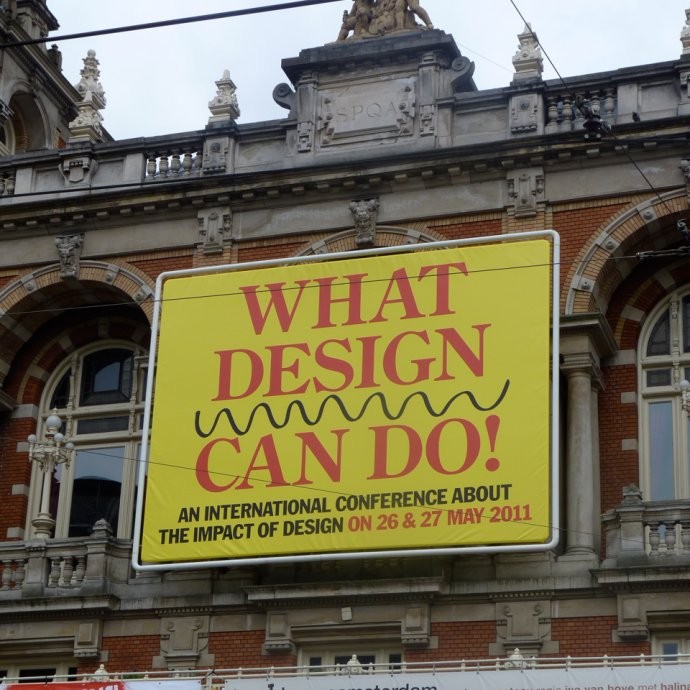From the Series

The second day of the What Design Can Do conference saw a few interesting speakers take the stage that not so much blew my mind, but that did have some rather interesting things to say. Having to split my time between watching the presentations and getting a chance to interview some of the speakers, my brain was feeling the design fatigue by the time the conference and the interviews were wrapped up. But that’s not to say I didn’t walk away with some inspiration for thought – a feeling I always look forward to when getting a chance to listen to some remarkable creative thinkers. Except for corporately cold presentation by Per Nimer, global design manager of Azko Nobels, one of the world's leading paint companies.
I want to take a quick look at some speakers that I was looking forward to and some that may have not been on my radar, but did pique my interests.
Scott Stowell
One of the few that peaked my interest, this fairly young American designer’s presentation ran along a theme of "pay attention" while he has a bevy of work under his belt already. More on the humorous side of the fence, Stowell runs his own design studio known as Open. The studio, as the name suggests, embraces a more informal nature of working by not really specialising in any one thing. In his lecture he touched on some of the projects Open has been involved in, from forming a strategy for Naked Pizza right through to creating a marketing campaign for Google’s apps for non-profits.
Stowell's work is largely based on creating a more interactive and feel-good experience for those that not only work for the brand, but for those who interact with the brand. For instance, with Naked Pizza, he was behind designing the super-hero-inspired suits for those delivering the pizza and the boxes as well. By creating this crazy idea of pizza delivers as super-heroes not only made delivering the pizza more fun for the deliverers, but also an experience for those waiting to get a bit of their deliciously warm pie.
After his presentation, Stowell was seemingly criticised by one of the moderators for using print more prominently than the web for his projects. Asked whether using a website to get a message across isn’t better and able to reach more people, Stowell confindently replied, “to who? Because when I order a pizza, I would much rather get a cool pizza box than stare down at a website”. It seems the web isn’t as infallible as it is made out to be.
Adelia Borges
While I knew what to expect from Adelia Borges, I was slightly worried. Here was a lecturer, journalist and curator, among other things, doing a presentation to a large contingency of designers and I wondered whether her talk wouldn’t be more “professor to students”, rather than “designer to designer”. Although at times it felt like she was about to go into an entire lecture on the history of Brazil and its colonisers, Borges was able to make some immensely poignant points. One such point was the impact of design on communities in Brazil and how design had for the longest time been a give and take in Brazil, the crafters give and the Western world takes, slaps on a label and calls it theirs. She explained that it’s about time that designers, should they want to use what’s has already been done, begin putting the names of those that were responsible for the idea in the first place. By creating this expanding and multi-cultural voice, developing countries such as Brazil would be able to flourish and begin creating an economic stability for those who have been underprivileged and living in slums, or even worse conditions.
Paula Dib
Once a pupil of Borges, it’s easy to see Paula Dib has the same idea about Brazil as her teacher does, but that is where the similarity ended for me. Dib is not a carbon copy of Borges and this is evident in the way that the two differ in their views regarding social design and its potential impact on communities, particularly those within the slums or in less privileged areas.
While Borges's focus lies particularly on Brazil, Dibs isn’t as concerned with locality. There is absolutely no doubt that she wants to see Brazil prosper when it comes to design and she has mapped out many of the impacts of social design on Brazil, but she also believes that it is more about everyone working together to make the impact of social design much more prominent. Dib started Trans.forma as a way to bridge the economical and social gap between what can be called the formal Brazil and the informal Brazil. What she hopes to achieve and has achieved is to get established and trained designers to work with the crafts people to create a vibrant community with much potential, but not necessarily a way to move forward.
Dib believes that it’s not about what people can get from someone else, but about what they can find to use that is already at their disposal. Design isn’t about just the end result, but it’s about the process and what it took to get to that end result and how this measures up in the end.
Saying that all people have the creative ability to find use in something simple from their surroundings, Dib disagreed with Toscani saying that creativity is present in everyone and not just some people. By getting people to collaborate and use their collective intelligence, Dib wants to create a sense of unity in the diversity of the communities she has worked with and remove the notion that everything has to be the idea of one person. A collective creative action is far more rewarding and, through partnerships, it is much easier to create a positive impact through those actions.
Lastly, there was Liu Xiaodu, an architect from China whose firm with two other partners specialises in urbanisation, with the firm aptly named Urbanus. But instead of getting into what he had to say, I would rather wait for the video interview we did with him to be posted. Watch this space. This man had much to say about where the world is at regarding urbanisation as well as a refreshingly different view on environmental sustainability. Urbanus has many projects on the go and the firm as well as Liu himself are definitely ones to keep an eye on.








